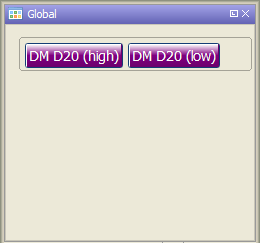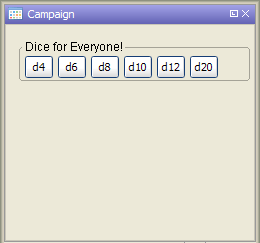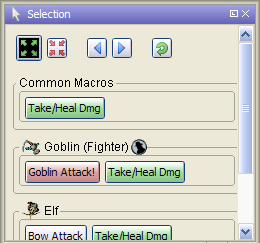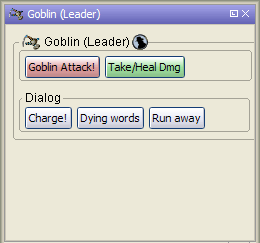MapTool User Interface
This article is a draft, be advised that information it contains may be incomplete, inaccurate, or unclear.
This is reference documentation of MapTool's user interface (UI) features including descriptions of all the menus and panels. It is intended for intermediate users who want to quickly learn about a particular feature, or to explore MapTool's UI features in detail.
If you are just getting started with MapTool, it is recommended to read the Introduction to Mapping, or visit the Main Page to browse for beginner articles.
Overview of the MapTool Application Window
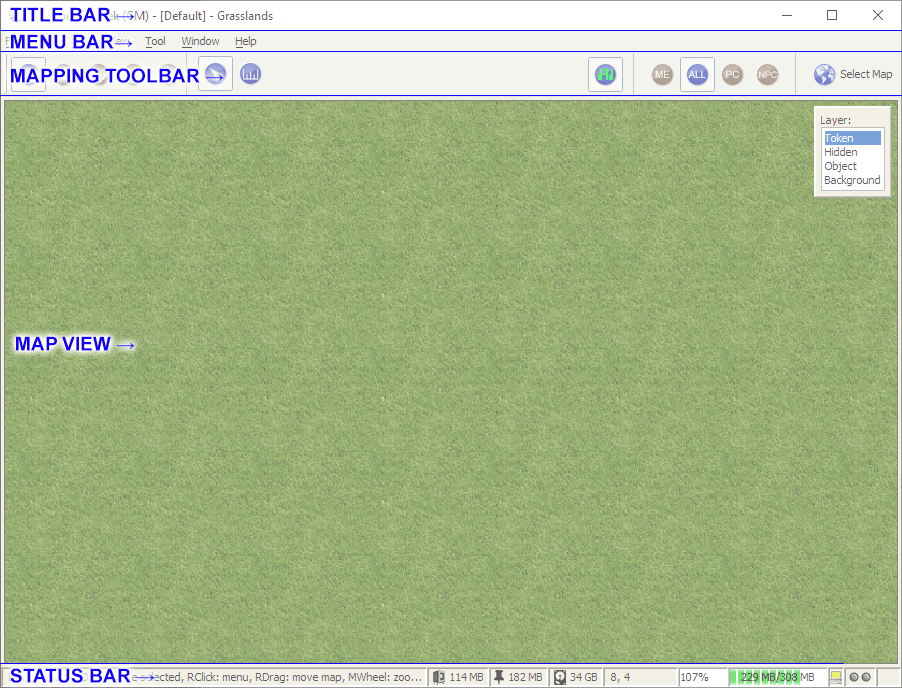
Each open instance of MapTool has an application window which contains a few ever-present components.
The application window always consists of a title bar, a menu bar, the map building and navigation tools, and the map view. One or more panels may be docked to sides of the map view or even floated seperate from the main application window.
The default layout also docks the `Resource Library` panel at the top left side, and a tabbed panel containing the `Map Explorer` and `Draw Explorer` in the lower left side, and the `Chat` panel. This default layout can be restored by selecting Window > Restore Layout.
Multiple instances of MapTool
Users may open multiple instances of MapTool at once, for instance to test the player view on one instance while serving a campaign file in another on the same computer. When doing this, each instance of the program will have its own application window with its own user interface.
If running multiple instances of MapTool, it is helpful to keep all panels in docked rather than floating to prevent confusion between open instances.
Menu bar
Maptool’s menu bar consists of seven dropdown menus. Underlined letters in a menu command indicates the hotkey that selects that command when the menu is open. Code styled commands next to a menu command indicate a default shortcut key for that command. The 'Meta' shortcut key listed is usually the Control key on Windows and Linux and Command on Mac. You can always verify your shortcut keys by looking in the menus of your MapTool installation.
File Menu
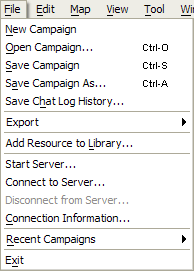
The File menu mainly contains Campaign File and networking commands, along with other miscellaneous export functions.
- New Campaign
- This creates a new campaign file with default properties, states, and a single map called 'Grasslands' configured according to the installation's new map defaults.
- Open Campaign...
[Meta-O]
- Opens a file explorer window to select and open a MapTool Campaign File.
- Save Campaign
[Meta-S]
- Saves the current campaign file. If it is a new campaign, MapTool opens a file explorer window to select a save location and name the campaign file.
- Save Campaign As...
- Opens a file explorer window to select a save location and name the campaign file.
- Save Chat Log History...
- Opens a file explorer window to select a save location and name an HTML file containing the entire content of the current chat panel.

- Export
- Submenu containing additional options.
- Screenshot
[Meta+Shift-S]
- Screenshot
- Opens the Export Screenshot dialog.
- Screenshot As...
- Opens the Export Screenshot dialog.
- Campaign As...
- Opens the Export Campaign dialog, which allows saving a campaign file in a format compatible with older versions of MapTool.
- Campaign Repository File...
- Opens a file explorer window to select a save location and name a ZIP file containing the entire content of the campaign for use as a Campaign Repository.
- Add Resource to Library...
- Opens the Add Resource to Library dialog, which will add new resources to the Resource Library.
- Start Server...
- Starts a new MapTool server from the current instance of Maptool with the currently open campaign file. See Networking.
- Connect to Server...
- Connect to a local or remote MapTool server.
- Disconnect from Server...
- Disconnect from the current server. This opens the campaign file which was open before connecting to a server.
- Connection Information...
- Displays additional connection information, such as the IP address.
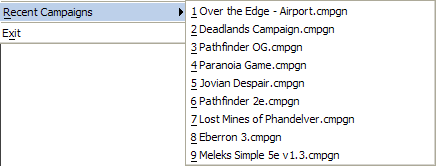
- Recent Campaigns
- Shows a list of up to 9 recently opened campaign files.
- Exit
- Will prompt the user to save the current campaign and close MapTool.
Edit Menu
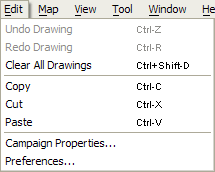
The Edit menu contains drawing and token editing commands and access to campaign settings and MapTool preferences.
- Undo Drawing
[Meta-Z]
- Removes the most recent drawing object that was created via the Draw tool.
- This menu command only affects drawings created with the Drawing Tool. Token movement can be undone by right-clicking a token and selecting 'Revert last move'. Token removal, and changes to the Vision Blocking Layer and Fog of War cannot be undone/redone. However, the key command may affect text in input areas such as the chat window and macro editor.
- Redo Drawing
[Meta-R]
- Re-adds the most recently drawing object that was removed via Undo Drawing.
- This menu command only affects drawings created with the Drawing Tool. Token movement can be undone by right-clicking a token and selecting 'Revert last move'. Token removal, and changes to the Vision Blocking Layer and Fog of War cannot be undone/redone. However, the key command may affect text in input areas such as the chat window and macro editor.
- Clear All Drawings
[Meta+Shift-D]
- Removes all items in the Draw Explorer on the current map.
- This menu command only affects drawings created with the Drawing Tool. Tokens, the Vision Blocking Layer, and Fog of War are not affected.
- Copy
[Meta-C]
- Copies a token to the clipboard.
- This menu command only affects Tokens, although the key command can affect text in input areas such as the chat window and macro editor.
- Cut
[Meta-X]
- Cuts a token, removing it from the map and placing it in the clipboard.
- This menu command only affects Tokens, although the key command can affect text in input areas such as the chat window and macro editor.
- Paste
[Meta-V]
- Pastes any token in the clipboard to the current map underneath the current cursor position.
- This menu command only affects Tokens, although the key command can affect text in input areas such as the chat window and macro editor.
- Campaign Properties...
- Opens the Campaign Properties dialog. These are settings which are saved with the current campaign such as token properties, states, and more.
- Preferences...
- Opens the Preferences dialog. These are settings which are saved with the local installation of MapTool. They are not saved with a campaign, and will need to be reconfigured on any new installation of MapTool.
Edit Menu - Expanded
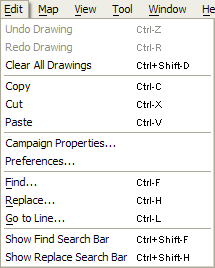
When one or more macro editors is open, the Edit menu is appended with editing options useful for macro authors. These extra commands only effect the macro editor, and can't be used with text entered into the chat panel or other text input areas. If multiple Macro Editors are open, these menu items will appear once for every open Macro Editor.
- Find...
Meta-F
- Opens the Find dialog box to search the macro editor for some arbitrary text. Works with Regular Expressions when 'Regex' is ✓checked.
- Replace...
Meta-H
- Opens the Replace dialog box to search the macro editor for some arbitrary text to replace with a second string of arbitrary text. Works with Regular Expressions when 'Regex' is ✓checked.
- Go to Line...
Meta-L
- Opens a simple Goto Line dialog box, letting you immediately transport the macro editor cursor to the line number provided.
- Show Find Search Bar...
Meta+Shift-F
- Toggles a bar with text search functionality docked to the bottom of the Macro window. If the Replace Search Bar is visible, the Find bar takes its place. Works with Regular Expressions when 'Regex' is ✓checked.
- Show Replace Search Bar...
Meta+Shift-H
- Toggles a bar with text search/replace functionality docked to the bottom of the Macro window. If the Find Search Bar is visible, the Replace Search Bar takes its place. Works with Regular Expressions when 'Regex' is ✓checked.
Map Menu
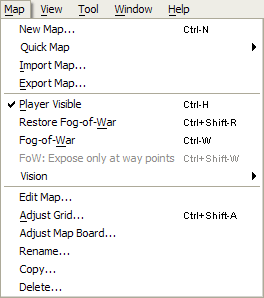
- New Map...
[Meta-N]
- Opens the 'Map Properties' dialog box to select options for a new map.
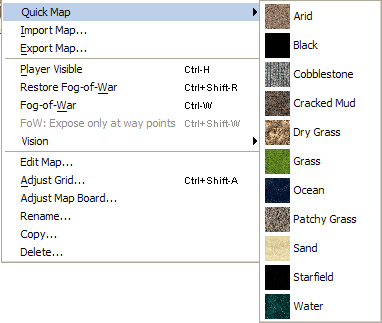
- Quick Map
- The Quick Map submenu provides a visual list of textures which, when clicked, instantly creates new maps with the settings configured in your MapTool_Preferences with the selected texture. Textures for the Quick Map submenu are automatically pulled from your Data Directory in the
Resources/Default/Texturessubdirectory. - You can add or remove textures from the default resources folder to alter the Quick Map options, but it is not recommended to remove Grass.png, as it is the default texture for all new MapTool maps and campaigns. If you do remove it without replacing it, a red 'X' will populate any new maps you create until you manually set a different texture in the map properties.
- Import Map...
- Imports a MapTool map with the
.rpmapextension via a file browser dialog into the open campaign. When importing maps with Fog of War, an option will be given to reset the fog for the whole map.
- Export Map...
- Exports a Maptool map with the
.rpmapextension to the local file system via a file browser dialog.
- Player Visible
[Meta-H]
- When ✓checked, the current map can be viewed by players and will be visible to them in the Select Map dropdown on the right side of the MapTool Toolbar.
- Restore Fog-of-War
[Meta+Shift-R]
- Resets any exposed areas of fog on the current map so they appear unexplored.
- Fog-of-War
[Meta-W]
- Enables the display of Fog of War.
- FoW: Expose only at way points
[Meta+Shift-W]

- Vision
[Meta-H]
- The vision submenu has controls how players can see tokens on the current map. When Fog of War is enabled, tokens under unexplored fog of war are always obscured regardless of which vision setting is selected. Also, these settings do not control when fog of war is revealed, which is controlled by a combination of client preferences and server settings. Aura effects are always rendered regardless of which Vision setting is checked.
- Troubleshooting tip: If players cannot see on the 'Day' or 'Night' settings, make sure player tokens are both owned by them and have 'Has Sight' checked in their properties.
- Troubleshooting tip: If players can't see anything on a map with Fog of War enabled regardless of these settings, try exposing an initial area of Fog of War around their tokens.
- Off
- When ✓checked, all tokens on the map (or explored areas of the map if Fog of War is enabled) will be shown to players regardless of token ownership, vision and light settings, and the Vision Blocking Layer (VBL). Hovering over Tokens with vision settings will still display a projected outline of what they can 'see' that accounts for the VBL.
- Day
- When ✓checked, players can only see the map and other tokens through tokens they own which have sight enabled in their preferences. Tokens will 'see' up to the maximum distance of their vision settings, and [[Introduction_to_Vision_Blocking}Vision Blocking Layer]] will block tokens from 'seeing' one another. Most light sources are ignored as all areas of the map is considered fully illuminated for vision purposes, though Auras remain visible.
- Night
- When ✓checked, players can only see the map and other tokens through their own tokens' vision just as with the Day setting, but additionally can only see into illuminated areas.
- Edit Map...
- Opens the Edit Map dialog to adjust the map's name, background color/texture, base map, fog color, grid settings, and vision distance.
- Adjust Grid...
- Enters an 'Adjust Grid' Map View mode to quickly find workable grid settings for the current map. The Map View's modal panel will change and display contain controls for grid size, x-y offsets, and color, as well as a map zoom slider. Further UI features of this mode are as listed:
- Left-clicking and dragging the Map View while this tool is open offsets the grid.
- Scrolling the mouse wheel or holding
Shiftand hitting the arrow keys will change the grid size. - Right-clicking and dragging will pan the Map View as usual, and holding the
Metakey while scrolling the mouse wheel will zoom the map as normal. - Clicking The 'close' button will save your changes and close Adjust Grid mode.
- Hitting the Escape key will exit the Adjust Grid mode without saving your changes.
- Adjust Map Board...
- Enters an 'Adjust Grid' Map View mode to adjust the position of a background map if any is set. This is the only way to adjust the position of the background map. The Map View's modal panel will change to display Snap to options and background map x-y offset values.
- Left-clicking and dragging will move the background map around. Right-clicking lets you pan the Map View as usual.
- The 'Snap to' option lets you either freely drag the map ('None'), snap the background to the grid as you drag it ('Grid'), or to the set repeating texture ('Tile').
- All changes are immediately saved and cannot be automatically undone. Clicking the 'close' button OR hitting the Escape key will exit the Adjust Map Board mode.
- Rename...
- Opens a dialog box to adjust the current map's name.
- Copy...
- Opens a dialog box to create a copy of the current map in the current campaign with a new name.
- Delete...
- Opens a dialog box to irreversibly remove a map from the current campaign. It is recommended to export any maps before deleting them unless you are sure you will never need them anymore.
View Menu
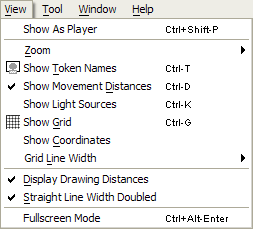
- Show As Player
[Meta+Shift-P]

- Zoom
- Zoom In
[ = ] - Zoom Out
[ - ] - Zoom 1:1
[ + ]
- Zoom In
- Show Token Names
[Meta-T] - Show Movement Distances
[Meta-D] - Show Light Sources
[Meta-K] - Show Grid
[Meta-G] - Show Coordinates

- Grid Line Width
- Display Drawing Distances
- Straight Line Width Doubled
- Fullscreen Mode
[Meta+Alt-Enter]
Tool Menu
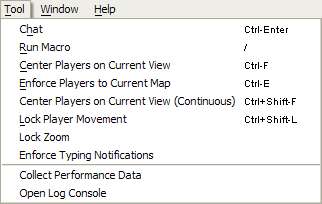
- Chat
[Meta-Enter] - Run Macro
[ / ] - Center Players on Current View
[Meta-F] - Enforce Players to Current Map
[Meta-E] - Center Players on Current View (Continuous)
[Meta+Shift-F] - Lock Player Movement
[Meta+Shift-L] - Lock Zoom
- Enforce Typing Notifications
- Collect Performance Data
- Open Log Console
Window Menu
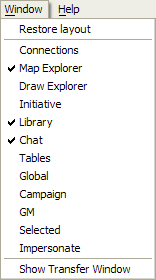
All panels will show as ✓checked when they are open. If you cannot find a panel, it may be in a tabbed panel or undocked from the Map View. Using the Restore Layout tool may help.
- Restore layout
- Resets to a default arrangement of panels docked to the left and bottom portions of the Map View. The default panels are the Map Explorer (lower left), Library (top left), and Chat (lower edge). All other panels are hidden and also have their default size and position reset.
- Connections
- Toggles the Connections panel. When playing on or running a server, this panel shows which players are currently connected.
- Map Explorer
- Toggles the Map Explorer panel. This panel shows all the Tokens on the currently selected map, organized by layer.
- Draw Explorer
- Toggles the Draw Explorer panel. This panel shows all the drawing objects (shapes, text, and cuts) on the currently selected map, organized by layer.
- Initiative
- Toggles the Initiative panel, which is a tool to help set and track rounds, current turn, and turn order for tokens on the the current map.
- Library
- Toggles the Library panel, a file browser to drag and drop images and tokens from added folders on the file system onto the map.
- Chat
- Toggles the Chat panel where all connected players can type, run chat commands, and run macros directly.
- Tables
- Toggles the Tables panel. Tables for the current campaign are created, configured, and can be run directly from this panel.
- Global
- Toggles the Global panel, which contains any macros attached to the current installation of MapTool.
- Campaign
- Toggles the Campaign pane, which contains any macros attached to the currently open campaign file.
- Selected
- Toggles the Selected panel, which contains any macros attached to the currently selected Token.
- Impersonate
- Toggles the Impersonate panel, which contains any macros attached to the currently impersonated Token.
- Show Transfer Window
Help Menu
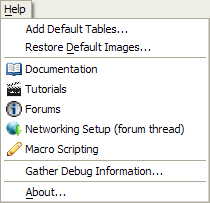
- Add Default Tables...
- Restore Default Images...
- Documentation
- Tutorials
- Forums
- Networking Setup (forum thread)
- Macro Scripting
- Gather Debug Information...
- About...
Toolbar and Map View
The MapTool Toolbar lets you interact with the Map View in different ways. The toolbar has a handle on the left side, allowing the user to undock it from the application window. Closing the popped-out toolbar or dragging it beneath the menu bar returns it to its default position.
About Map View
Beneath the Toolbar's default position, most of the application window is used to display the current map. Any docked panels will appear alongside the Map View. Map view is semi-modal, meaning its use and options change somewhat depending on the tools and menu options you select.
Controls in the Map View
In most modes, MapTool describes the available commands for the Map View in the #Status Bar at the bottom-left of the application window. The following controls are what are available to players and GMs using the 'Pointer' tool:
Left click: Select a token.Left click + drag: If no tokens are selected, drag a selection box to select multiple tokens. If a token or token(s) are selected, move selected token(s).
Left click + drag + SpacebarorLeft click-drag + Right Click: While moving a token, set waypoints to control the path taken.
Right click: Open a token's right-click context menu.Right click + drag: Pan the Map View.Mouse Wheel: Zoom the Map View in/out.Spacebar: Holding spacebar will show a blue arrow on the map pointing to your cursor position to all connected players. Your name is shown next to the arrow.Meta + Spacebar: Changes the pointer image to a cartoon-style speech bubble.Shift + Spacebar: Changes the pointer image to a cartoon-style thought bubble.Meta + Shift + Spacebar: Changes the pointer image to an illustrated pointing hand.
Modal Panel
For GMs, the Map View usually has a small panel present in the top right. This panel most often displays the different map layers so the GM can choose which layer to interact with. Following is a rundown of the different modal panels that exist in MapTool.
- Layers Selection
- This panel lets the GM select which layer to use their pointer, draw (except the text tool), or template tools on.
- Color and Stroke Options
- This panel is displayed to GMs and Players when the Drawing and Template tools are selected, except for the Text tool. For GMs, this panel is appended with the option to select layers.
- No Panel
- The modal panel is not displayed at all when the Measure, Fog of War, Text, or Vision Blocking tools are selected. The panel is also not shown for players connected to a server using Interaction tools, since they cannot interact with anything but the Token layer.
- Adjust Grid Settings
- This is a special mode accessed by GMs under the Map Menu.
- Adjust Map board Settings
- This is a special mode accessed by GMs under the Map Menu.
Toolbar Overview
Interaction Tools
Drawing Tools
Template Tools
Fog of War Tools
Vision Blocking Layer (VBL) Tools
Volume Slider
AI Pathfinding Toggle
Fog of War View Buttons
Select Map Dropdown
Panels
Panels are windows which expose additional MapTool features. They can be toggled visible or hidden by using the Window menu, and their position is customizable; they can be docked to the edge of the Map View, resized, tabbed to share a location with other panels, and floated apart from the application window entirely.
You can reset all the panels by Selecting Restore Layout from the Window menu. MapTool saves the current panel configuration when it is closed.
Connections
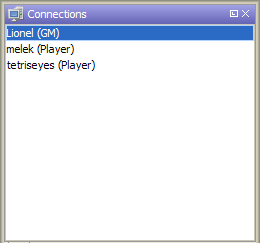
When playing on or running a server, this panel shows which players are currently connected.
Map Explorer
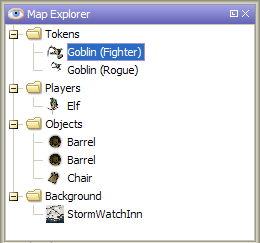
This panel shows all the Tokens on the currently selected map, organized by layer.
Draw Explorer
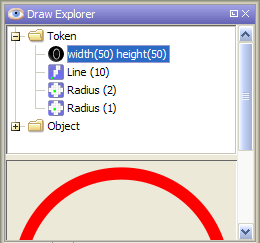
This panel shows all the drawing objects (shapes, text, and cuts) on the currently selected map, organized by layer.
Initiative
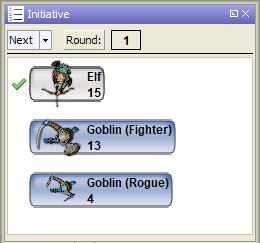
A tool to help set and track rounds, current turn, and turn order for tokens on the the current map.
Library
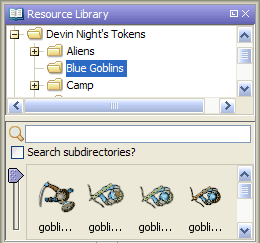
A file browser to drag and drop images and tokens from added folders on the file system onto the map.
Chat
Panel where all connected players can type, run chat commands, and run macros directly.
Tables
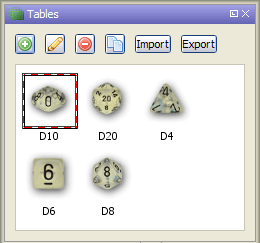
Tables for the current campaign are created, configured, and can be run directly from this panel.
Macro Panels
Global
Contains any macros attached to the current installation of MapTool. Global macros are saved when MapTool is properly closed, are not available to other connected players on a server.
Campaign
Contains any macros attached to the currently open campaign file. Campaign macros are saved with the campaign, and when on a server are available to all connected players.
Selected
Contains any macros attached to the currently selected Token(s). It also lists identical macros across tokens in a 'Common Macros' area at the top of the panel, if relevant. Token macros are saved with the token, and are available to any GMs or owners of the token on a server.
Impersonate
Contains any macros attached to the currently impersonated Token. Token macros are saved with the token, and are available to any GMs or owners of the token on a server.
Status Bar
Other Key Windows
The following additional dialog windows are key parts of using MapTool for the majority of users.
- Campaign Properties Window
- Preferences Window
- Macro Editor Window
- Networking Windows
